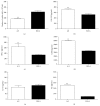Resistance to P. brasiliensis Experimental Infection of Inbred Mice Is Associated with an Efficient Neutrophil Mobilization and Activation by Mediators of Inflammation
- PMID: 26819497
- PMCID: PMC4706933
- DOI: 10.1155/2015/430525
Resistance to P. brasiliensis Experimental Infection of Inbred Mice Is Associated with an Efficient Neutrophil Mobilization and Activation by Mediators of Inflammation
Abstract
Paracoccidioidomycosis (PCM) is a systemic fungal infection, endemic in Brazil, that leads to severe morbidity and even mortality if not correctly treated. Patients may respond differently to PCM depending on the pattern of the acquired immune response developed. The onset of protective immune response is notably mediated by neutrophils (PMN) that play an important role through directly killing the fungi and also by interacting with other cell types to modulate the acquired protective immune response that may follow. In that way, this study aimed to present and compare different experimental models of PCM (intraperitoneal and subcutaneous) regarding PMN production and maturation inside femoral bone marrow and also PMN infiltration in peritoneal and subcutaneous exudates of resistant and susceptible mice. We also assessed the fungal colony forming units and the levels of soluble inflammatory mediators (LTB4, KC, IFN-γ, GM-CSF, and IL-10) inside subcutaneous air-pouches to compare the efficiency of the PMN present at this site in relation to the two main neutrophil functions: initial lysis of the invading pathogen and modulation of the acquired immune response. P. brasiliensis inoculated intraperitoneally was able to disseminate to the bone marrow of susceptible mice, causing a more marked alteration of PMN production and maturation than that observed after resistant mice infection by the same route. Subcutaneous air-pouch inoculation of P. brasiliensis elicited a controlled and limited infection that produced a PMN-rich exudate, thus favoring the study of the interaction between the fungus and the neutrophils. Susceptible mice produced higher numbers of PMN; however, these cells were less effective in killing the fungi. Inflammatory cytokines were more pronounced in resistant mice, which supports their PCM raised resistance.
Figures






Similar articles
-
Paracoccidioidomycosis Protective Immunity.J Fungi (Basel). 2021 Feb 13;7(2):137. doi: 10.3390/jof7020137. J Fungi (Basel). 2021. PMID: 33668671 Free PMC article. Review.
-
Neutrophil oxidative metabolism and killing of P. brasiliensis after air pouch infection of susceptible and resistant mice.J Leukoc Biol. 1996 Apr;59(4):526-33. doi: 10.1002/jlb.59.4.526. J Leukoc Biol. 1996. PMID: 8613700
-
Resistance to Paracoccidioides brasiliensis infection is linked to a preferential Th1 immune response, whereas susceptibility is associated with absence of IFN-gamma production.J Interferon Cytokine Res. 2000 Jan;20(1):89-97. doi: 10.1089/107999000312766. J Interferon Cytokine Res. 2000. PMID: 10670655
-
Fungistatic and fungicidal activities of murine polymorphonuclear leucocytes against yeast cells of Paracoccidioides brasiliensis.Med Mycol. 1999 Feb;37(1):19-24. Med Mycol. 1999. PMID: 10200930
-
Cytokines produced by susceptible and resistant mice in the course of Paracoccidioides brasiliensis infection.Braz J Med Biol Res. 1998 May;31(5):615-23. doi: 10.1590/s0100-879x1998000500003. Braz J Med Biol Res. 1998. PMID: 9698765 Review.
Cited by
-
Myeloid-derived suppressor cells are associated with impaired Th1 and Th17 responses and severe pulmonary paracoccidioidomycosis which is reversed by anti-Gr1 therapy.Front Immunol. 2023 Jan 26;14:1039244. doi: 10.3389/fimmu.2023.1039244. eCollection 2023. Front Immunol. 2023. PMID: 36776848 Free PMC article.
-
Paracoccidioidomycosis Protective Immunity.J Fungi (Basel). 2021 Feb 13;7(2):137. doi: 10.3390/jof7020137. J Fungi (Basel). 2021. PMID: 33668671 Free PMC article. Review.
-
The Role of the Interleukin-17 Axis and Neutrophils in the Pathogenesis of Endemic and Systemic Mycoses.Front Cell Infect Microbiol. 2020 Dec 14;10:595301. doi: 10.3389/fcimb.2020.595301. eCollection 2020. Front Cell Infect Microbiol. 2020. PMID: 33425780 Free PMC article. Review.
-
Paracoccidioidomycosis: Current Status and Future Trends.Clin Microbiol Rev. 2022 Dec 21;35(4):e0023321. doi: 10.1128/cmr.00233-21. Epub 2022 Sep 8. Clin Microbiol Rev. 2022. PMID: 36074014 Free PMC article. Review.
References
-
- Sperandio F. F., Giudice F. S., Coelho A. P. C. G. B., De Sousa S. C. O. M., Martins M. T. Difficulty in diagnosing oral paracoccidioidomycosis after topical nystatin usage. General Dentistry. 2012;60(1):e44–e46. - PubMed
-
- Cabral-Marques O., Schimke L.-F., Pereira P. V. S., et al. Expanding the clinical and genetic spectrum of human CD40L deficiency: the occurrence of paracoccidioidomycosis and other unusual infections in brazilian patients. Journal of Clinical Immunology. 2012;32(2):212–220. doi: 10.1007/s10875-011-9623-6. - DOI - PubMed
Publication types
MeSH terms
Substances
LinkOut - more resources
Full Text Sources
Other Literature Sources

